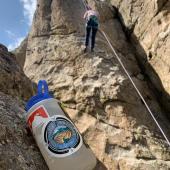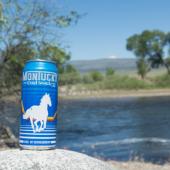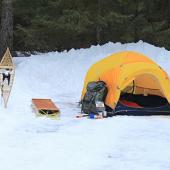Snowshoe Ghost Hunt
After my backcountry skiing plans fell through, I needed another activity to fill the afternoon. I heard there was good snowshoeing to be had near Elkhorn – a ghost town that had acquired a few living residents, some nine miles southeast of Boulder. I set out in search of outdoor recreation and the thrill of visiting a possibly haunted piece of Montana's past.
Elkhorn is 11 miles off MT-69 at the end of a gravel road. Upon reaching the town, I was met by a sign summarizing Elkhorn’s history. The town was established in 1870 when multiple silver outcroppings were discovered. In the 1880s, miners discovered additional caches of lead, silver, and gold, causing a brief boom era. The population peaked at about 2,500 and supported a host of shops, restaurants, fraternal organizations, and a whopping 14 saloons (that’s one watering hole per 180 inhabitants, making those some seriously thirsty miners). Sadly, the silver market crashed in 1893, causing the town to wither. By the early 1900s, the low price of silver and a diphtheria epidemic left the town nearly empty. Though Elkhorn has managed to sustain a few smaller mining operations on and off throughout the century, the town has remained mostly empty since. Livable houses are far outnumbered by dilapidated ones.
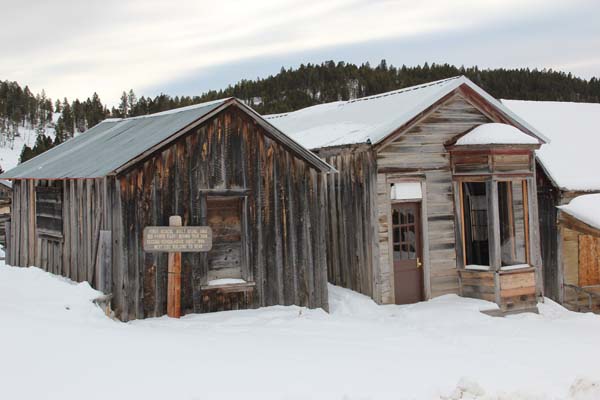
A final notice on the sign crushed my aspirations of exploring abandoned buildings: “All buildings are private property. No Trespassing.” So much for my ghost-busting dreams.
As for my snowshoeing aspirations, there was another barrier: I had no idea where to find the trailhead. I figured that needing directions would be an excellent excuse to make conversation with a local and learn a bit about the ups and downs of living in an isolated ghost town. Plus, the thrill of meeting a potentially deranged shut-in or outlaw would make up for my inability to get a good scare exploring abandoned buildings. Since I could not disturb the restless dead, I may as well pester the living.
I walked up and down the only plowed road in sight. The town had clearly been done-up a bit for visitors. A few of the ancient buildings had signs describing their original purpose: “Barbour Shop”, “Candy Store”, and “Mercantile” signs remain even where the buildings they mark have not. Finding no active bar, coffee shop, or business of any kind (save, of course, the active gold mine lurking behind a large chainlink gate north of the town center), I had no choice but to seek people out in the privacy of their homes. There were several houses in sight that appeared presently inhabited (or at least inhabited in the 21st century). Two had smoking chimneys. One was guarded by a surly-looking three-legged dog. The second cabin was behind a newly built (but closed) country store. I went for option B, reasoning that if they were the owners of a country store, they were probably vaguely open to interacting with strange lone women confusedly marching around their yard with a camera. Unless I was about to awaken them from some kind of hibernation mode—whereupon I would no doubt face death by antique mining-tool impalement. I figured it was worth the gamble. How else could I justify the tank of gas required to get here and home?
After knocking, I was greeted by a kind-looking middle-aged woman and a host of small dog yips. I introduced myself, explaining that I was trying to get to the trailhead for a snowshoeing jaunt. The woman, named Carla, and her husband Tom were more than willing to discuss Elkhorn life (and death). Tom, who had family members living in Elkhorn since the ‘30s, worked in one of the mines starting in the late ‘60s. They are two of three people inhabiting Elkhorn (the other, the owner of the aforementioned three-legged dog, lives across the way with no running water). Elkhorn appealed to them as a peaceful and inexpensive retirement option. Tom spends his time fixing up the country store to open in the summer, and Carla enjoys crafting souvenirs to sell in it. I realized early on that two less mentally unhinged people couldn’t be found in the county. Tom and Carla pointed me in the direction of the trailhead, telling me to keep an eye out for one of the nation’s last standing Union Pacific railroad water towers. Both relieved and a tad disappointed, I made for the trail.
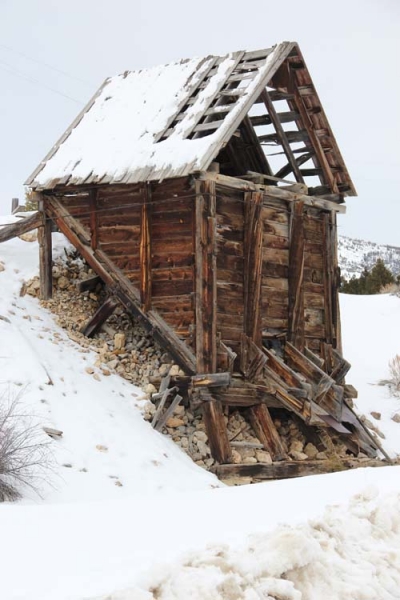
Elkhorn was fortunate to have several feet of snow on the ground. I snowshoed a quarter-mile around the base of a large hill and on my left, I saw it: a leaning, cylindrical water tower, strips of red paint remaining some hundred-odd years after the tower was first erected. It’s a remnant of a fleeting industrious time for Elkhorn. But then, in the slanted 4pm light of the quiet forest, it seemed less a ghost and almost a natural part of its now wild environment. The tower, given a ten-foot berth by the trees, shimmered in a snowy halo, framed by the pines surrounding it. I continued on my way, around the hill in search of a graveyard that refused to show itself, presumably, lying hidden beneath the snow.
That town has some secrets, to be sure. Some things die with the era that birthed them while others survive through the words that carry their story, and the kindness of the people willing to share the tale.







